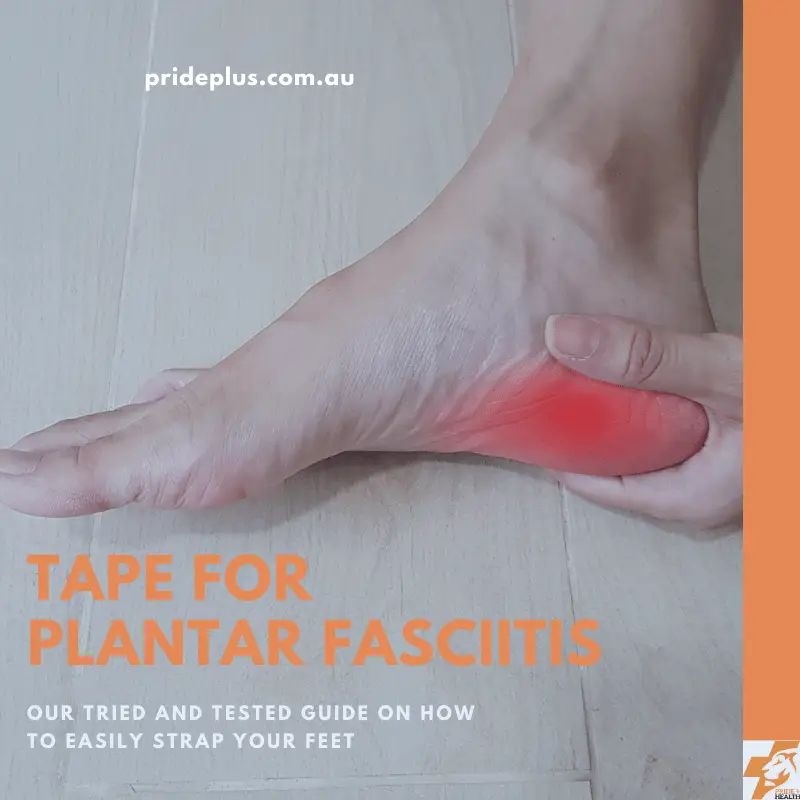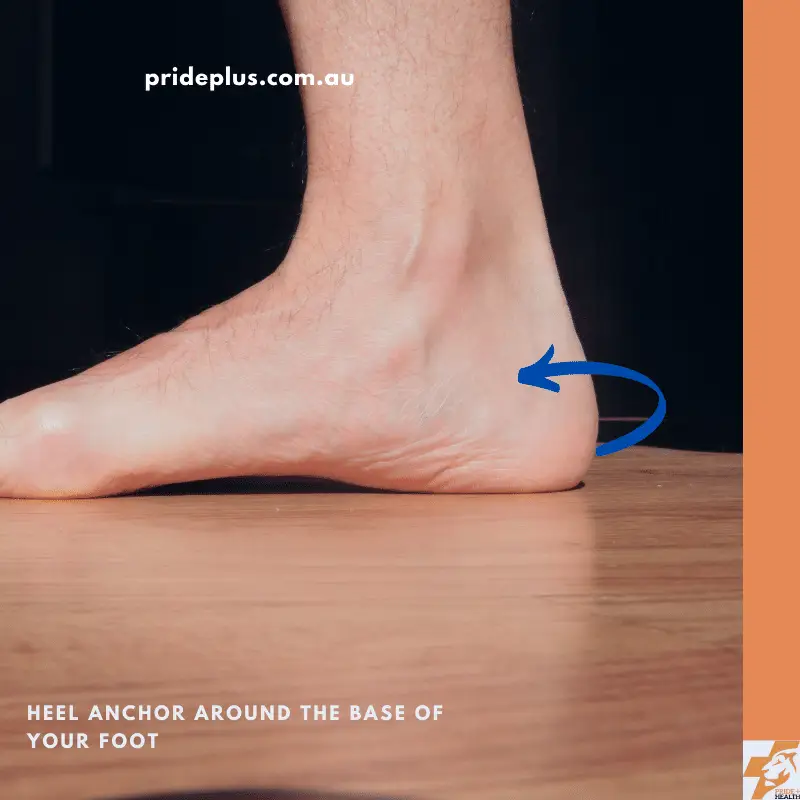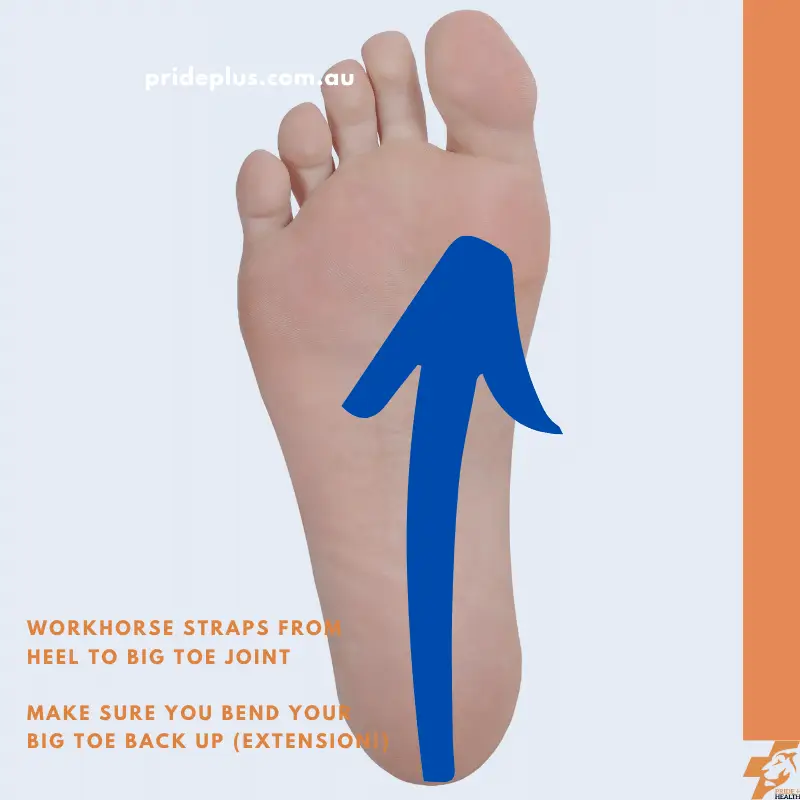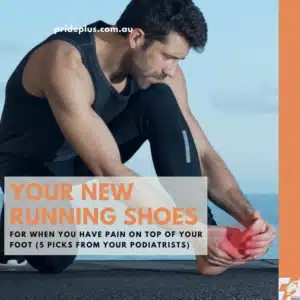A great way to reduce the plantar heel pain is to use an effective technique to tape for plantar fasciitis relief.
We’ve written extensively and helped thousands across Melbourne in clinic with their plantar fasciitis pain. Whether it be all about the treatment of plantar fasciitis, the best shoes for plantar fasciitis or even different orthotics for plantar fasciitis we’ve got you covered.
In this post we’ll teach you the easiest way for you to effectively tape for plantar fasciitis pain relief.
Few warnings and advice off the top.
Nothing, and we mean nothing beats getting your own personal treatment plan from your podiatrist.
If you haven’t yet booked in with your PridePlus Health podiatrist do that here.
Secondly, this is general advice. Unless we’ve specifically advised you in the clinic to follow this guide this is strictly tape for plantar fasciitis at your own risk.
Thirdly, make sure your feet are clean, free of skin damage and that you’re not allergic to the tape you’re going to use.
How To Tape for Plantar Fasciitis
We’ve honed this taping technique down after years of clinical practice. This is by far the simplest way to tape for plantar fasciitis that has a background in anatomy and physics for effectiveness.
You’re basically following the band of tissue from where it starts to where it finishes with a strip of tape or two to prevent plantar fascia strain or overload.
Step 1: Prepare
First you need to get a rigid athletic tape.
You can get varying qualities of athletic tape and also varying sizes.
Our preferred is the premium elastoplast sports tape in the 38mm thickness.
You’ll also need to make sure your skin is clean and dry, free from damage and tinea pedis.
Step 2: The Heel Anchors
Prepare 2 anchors (these will be your 1st and 4th pieces of tape) by tearing or cutting a 5cm to 8cm piece of tape.
I usually tear this in half again lengthwise to reduce the amount of excess tape used on the skin, and save about 2 cents in total tape usage.
Place the first anchor now around the back of your heel, just above the sole but not so high as to reach up onto your achilles tendon.
Save the 2nd anchor for step 4.
Step 3: The Workhorse Straps
The next two straps are the ones which do all the work and need to be placed tight and precise.
Measure from the back of the heel anchor to the big toe joint a the ball of the foot (known as the 1st MTPJ).
Cut or tear two of these pieces.
Now, when bending your big toe back up to you (lifting the toe to increase your arch height) run the tape from the 1st anchor, to the big toe joint.
Repeat with the 3rd piece of tape.
Now gently massage the tape back against your arch and foot as you relax your big toe.
It’s ok for the tape to want to pull away from your arch but it must stay secured to your heel and your 1st MTPJ.
Step 4: Place the 2nd Heel Anchor
Using that small piece left over from before strap over the top of the first anchor.
This locks the 2 workhorse straps at the back of your heel.
That’s it for the strapping, you’re done.
The tape should feel tight, secure and not-uncomfortable.
Pop your socks on and shoes on to keep the strapping tape clean and on your foot.
A gentle warm hand massage for 30 seconds helps the glue stick even better to the skin too.
Now that you’ve strapped up your foot for plantar fasciitis pain relief, let’s learn a little more about what’s happening with the sticky stuff on your skin.
How Does It Work?
How Does Taping The Plantar Fascia Help?
The pain you feel from plantar heel pain is your body signalling that the plantar fascia has been working too hard, and something needs to change.
The tape for plantar fasciitis works in two ways.
First by limiting the extension of the plantar fascia during the heel-strike to mid-stance phase of gait. The time when you first hit the ground to when your foot is fully loaded.
Usually your plantar fascia undergoes tensile (pulling) loading at this time.
By using the rigid athletic tape from your heel to your big toe joint (1st MTPJ) you limit this over-extension.
The second is that by pulling on your big toe joint you increase the loading of the big toe from mid-stance into transition.
This is the time your heel starts to lift off the ground.
If your heel twists (inverts) a lot at this time it compresses the plantar fascia, something which it does not love too much of.
The anchoring of the big toe to the ground reduces this extra load as well.
Will Taping Cure Plantar Fasciitis?
Not necessarily, but it can be a valid piece of the puzzle.
Taping will reduce the peak loading on the plantar fascia, which can allow repair to start to occur.
But if there are other factors at play limiting your bodies ability to repair such as poor sleep, nutrition, or chronic disease then these will need to be addressed as well.
Also taping will reduce the peak loading on the plantar fascia, but it does not target the contractile cells within the plantar fascia which can be trained like a muscle or tendon. Exercises in combination with taping often work much better.
What About Kinesiology Tape?
That bright coloured kinesiology tape sure catches the eye, but it does not catch the foot quite as well.
As kinesiology tape is highly flexible it’s unable to limit the elongation of the arch and thus as a taping technique is not as effective.
If I was stuck in the bush (or trekking kokoda) with plantar fasciitis and only had kinesiology tape handy I’d certainly give it a go, but I’d also wonder what on earth happened to the rigid strapping tape that lives in my first aid kit whenever I venture into the great outdoors!
What Next After Plantar Fasciitis Taping?
The Tape Removal Process
To remove your strapping tape you can gently peel it back from the big toe joint back to the heel.
If you’ve been playing sports or sweating it will probably come off quite easily.
For those who have much drier skin or fragile skin it’s better to get it wet in the shower.
But please, be gentle!
Transition From Short-Term Management
Applying tape to your foot for pain relief is great in the short term, but if you need to optimise the load on your foot for a longer period of time then other treatments should be implemented.
A custom orthotic which reduced the peak loading on your plantar fascia can be an effective way to replicate strapping, without actually strapping.
It’s certainly easier to set and forget a pair of orthotics in your shoes than have to apply tape every morning after a shower!
If you’re in need of a custom foot orthotic for your plantar fasciitis you’ll appreciate our orthotic guarantee.
What To Do If Taping Does Not Change Your Symptoms?
The management of plantar heel pain is complex.
If these taping techniques aren’t effective then there’s a good chance you have a different diagnosis.
You’ll need to get assessed and sorted by your expert podiatrists at PridePlus Health.
Related post on how to strap for plantar fasciitis in under 1 minute.






